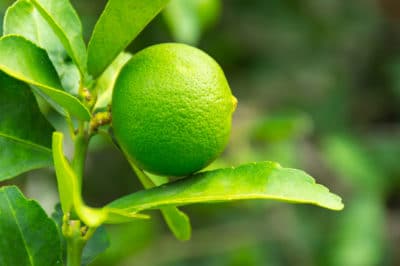Whether they grow outdoors in the ground or indoors in pots, evergreen lime trees need lots of water. They just don’t need — and won’t tolerate — overwatering that leads to standing water around their roots. Overwatering is a major cause of yellowing lime tree leaves.
The Solutions:
To avoid overwatering outdoors:
- Plant lime trees in well draining, sandy loam soil if possible.
- Amend poorly draining soil in advance with a 4-inch layer of organic compost worked into the top 10 inches of your planting site.
- Let the top 6 inches of soil dry before watering established lime trees. The time this takes depends on rainfall, soil drainage and where your trees are in USDA hardiness zones 8 through 11.
To avoid overwatering indoors:
- Plant your lime tree in a container with drainage holes.
- Use a growing mix formulated for citrus trees, or make your own consisting of 2 parts organic potting soil to 1 part coco fiber or perlite.
- Water slowly and deeply only after the top 1 inch of soil feels dry.
- Empty the drainage saucer immediately.
Soil pH Problems
Outdoor lime trees thrive with a slightly acidic to neutral soil pH between 6.5 and 7.0. If a soil test shows significantly higher or lower numbers, your trees could be at risk of leaf yellowing from poor nutrient absorption.
Correcting Overly Acidic Soil
To raise the pH organically, amend your oil with phosphorous-rich wood ash. A little goes a long way; ½ cup (64g) scattered around a large lime tree and covered with a 1-inch layer of compost will do the job.
Expert gardener’s tip: Wood ash releases its phosphorous so slowly that it may take your tree’s leaves several weeks to begin greening up. But a single application should keep them green for at least three years.
Correcting Overly Alkaline Soil
Organic elemental sulfur granules gradually lower soil alkalinity. Scatter them around your in-ground trees at the rate of 2 ½ tablespoons (37.5g) for every 10 square feet of soil and work them in. For potted trees, use 1 tablespoon (15g) for every 4 inches of pot diameter.
Soil bacteria break the granules down into pH-lowering sulfuric acid. The soil’s moisture, temperature and bacterial content determine how quickly it happens.
Expert gardener’s tip: Don’t apply the sulfur more than twice — or try to lower your pH reading by more than 1 unit — in a single year.
